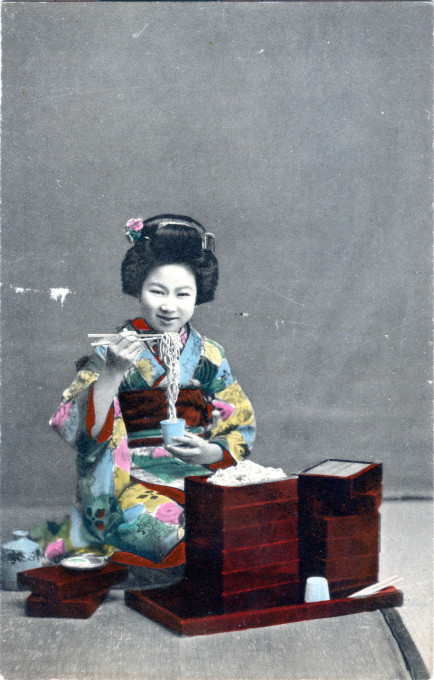“The main ingredient of soba is buckwheat – a primitive grain that is eaten rarely in the United States. However, buckwheat is the best and, in some cases, the only source of bio-compounds that are vital to the healthy functioning of cells and enzymes.
“… Buckwheat is unusually rich in protein (12 to 15 percent) and the essential amino acid lysine, which is lacking in most grains. Buckwheat is also abundant in lipids, minerals (iron, phosphorus and copper), and vitamins B1 and B2.
“This wonder grain is also high in rutin (4 to 6 percent). Rutin is important because it strengthens capillaries and thus helps people suffering from arteriosclerosis and high blood pressure.”
– Japanese Foods That Heal, by John Belleme & Jan Belleme, 2007

“Maiko eating noodles”, c. 1910, a variety of soba called zaru soba, chilled noodles dipped in soba tsuketsuyu.
See also:
“Eating with chopsticks”, c. 1910.
“Soba is the Japanese name for buckwheat, and it is synonymous with a type of thin noodle made from buckwheat flour. (Note also that there are a few noodle dishes named ‘soba’, e.g. yakisoba, chukasoba or Okinawa soba, that are not made with buckwheat noodles.) Like many Japanese noodles, soba noodles are often served drained and chilled in the summer, and hot in the winter with a soy-based dashi broth.
“Chilled soba is often served on a sieve-like bamboo tray called a zaru, sometimes garnished with bits of dried nori seaweed, with a dipping sauce known as soba tsuyu on the side. Using chopsticks, the diner picks up a small amount of soba from the tray and dips it in the cold tsuyu before eating it. Wasabi and scallions are often mixed into the tsuyu. Many people think that the best way to experience the unique texture of hand-made soba noodles is to eat them cold, since letting them soak in hot broth changes their consistency.
“Soba has been eaten in Japan for centuries (there are records of buckwheat flour being grown to help fight a famine in the Nara period [710 CE to 794 CE]), but became a main staple of the Kanto region during the Edo period, when the wealthy of the region began to prefer white rice – low in thiamine – over the thiamine-rich brown rice, and buckwheat became the main source for thiamine instead. Soba noodles were thus not only a comfort food, but also a necessary source for nutrients.
“The first time soba noodles appeared in Edo literature was when ‘soba’ was mentioned in the Jisho Diary (1614), written by the monk Jisho of the Sonshoin Temple in Kyoto. The entry of February 3rd shows that he ate buckwheat noodles with two companions when they went to a bathhouse but could not enter because it was too crowded.”
– Wikipedia


Pingback: “Hard boiling seller”, oden street vendor, c. 1920. | Old TokyoOld Tokyo
Pingback: “Buckwheat noodle (soba) house” deliveryman, c. 1920. | Old TokyoOld Tokyo